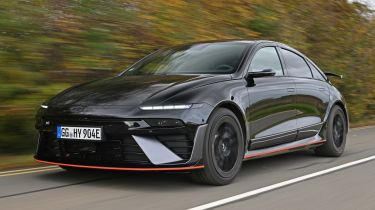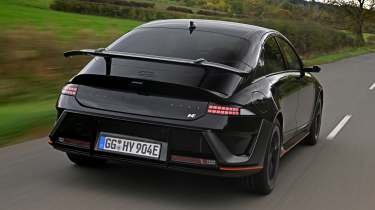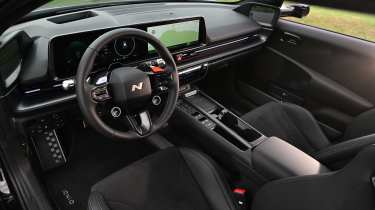New Hyundai Ioniq 6 N 2025 review: who needs a V8?
The new Hyundai Ioniq 6 N takes everything that's great about the Ioniq 5 N and turns it up another notch

Verdict
The Hyundai Ioniq 6 N is as close as you’ll come to a true driver’s EV. That’s not intended to damn it with faint praise, either; the saloon takes the excellent 5 N as a base and elevates things to the next level. The way it rides and handles, and just the way it makes you feel, beggars belief. No amount of instant torque or trick simulated gearbox tech will ever replace a naturally aspirated V8, but this latest N model comes within a hair’s breadth.
It’s almost two years since we first drove the Hyundai Ioniq 5 N in South Korea. We came away from the global launch wondering whether the brand’s inaugural performance EV really was as good as it seemed, itching to drive it again on more familiar roads.
Six months passed until we got one in the UK. But it didn’t take long to dispel any fear that we’d overcooked our verdict, declaring the hot hatch a “new benchmark” for driver-focused electric cars. The hype was real.
Fast forward to now, and we’re finally getting a chance to sample N’s second electric offering. Based on the facelifted Hyundai Ioniq 6 also due next year, the 6 N’s stats largely mirror those of its boxier 5 N brother – with a couple of key changes that should make it even better to drive.
Used - available now

2020 Audi
A3 Sportback
37,838 milesManualPetrol1.0L
Cash £13,300
2021 Ford
Focus Estate
28,497 milesManualPetrol1.0L
Cash £13,900
2024 BMW
5 Series Touring
70,710 milesAutomaticDiesel2.0L
Cash £20,800
2023 MG
ZS EV
7,979 milesAutomaticElectric
Cash £14,366The first is an advanced suspension geometry that has been fully redesigned for the Ioniq 6. Hyundai has increased the axle stiffness, steering precision and mount damping, which it says “enhances comfort and refinement across all road surfaces”. We covered a variety of roads on our autumnal UK test, but at no point did we encounter anything that upset the sleek saloon’s steadfast composure; the go-faster 6 rides with a compliance that the 5 N can’t match.
That focus on refinement is another thing that’s obvious the moment you start rolling. The Ioniq 6’s streamlined shape makes this one of the quickest and quietest cars on sale – with little noticeable road or wind noise even at the national speed limit. Features such as the motorsport-inspired rear wing and widened track do little to harm the car’s drag coefficient, which stands at 0.27Cd.
Which is just as well, because the 6 N certainly isn’t short of visual presence – especially with our car’s deep black paintwork and matching wheels. To our eyes, the updated Ioniq 6 is a cleaner, meaner design, lending itself perfectly to the N’s muscular makeover.
Hyundai claims the new car’s “stroke-sensing Electronically Controlled Suspension (ECS) dampers and lowered roll centre work together to enhance grip and stability” and even in damp conditions the saloon feels absolutely unflappable. The revised steering set-up hasn’t improved the feel, but it’s resolutely direct; this is a car that’ll change direction on a sixpence, without a hint of understeer. The Pirelli P-Zero tyres strike a good balance between comfort and handling, keeping the car glued to the road even in cool temperatures.
Then there’s the enhanced N-eShift system, which has been tuned with shorter ratios. The paddle-operated set-up works wonderfully, and we reckon it’s the closest any maker has come to replicating an ICE-car transmission in an electric car. It limits torque and bogs down when you’re in the wrong ‘gear’, and will even hit its imaginary limiter if you don’t change up in time. Firing home the next cog brings with it a subtle kick in the back like you might get in a fiery dual-clutch hot hatch.
Linked to the shift system is an “improved sound” apparently achieved through “meticulous acoustic fine-tuning”. It still won’t be to all tastes – it remains recognisably synthetic, emphasised by how separate the engine sound feels from the fabricated pops and bangs from this car’s non-existent exhaust – yet it adds a level of character that would otherwise be missing in a car of this type. You can switch it off if it’s not to your liking, but as a point of difference, we like what it adds to the overall driving experience.
The brakes are strong, and cope well with repeated hard stops – showing that this is not only a better road car than the 5 N, but sure to be more accomplished on track, too. Some of the strain is taken by Hyundai’s excellent-as-always multi-stage regenerative braking set-up, which when you’re not using the paddles to change gear, allows you to increase or decrease the level of recuperation.
Make no mistake, the Ioniq 6 N is a very fast car, no matter the type of road you’re driving on. While the throttle response may not have the urgency of a Tesla Model 3 Performance, acceleration is blistering: 0-62mph takes just 3.2 seconds. And if that’s not enough, it’ll keep on pulling to 160mph.
Yet this might be one of the few EVs where you can exploit that level of pace and performance without unduly worrying about how long you’re going to spend topping up the batteries. While we didn’t get to experience the benefits of this car’s 800-volt electrical architecture first hand, our host from Hyundai showed us screengrabs of our car hitting 256kW on an Ionity rapid charger in Belgium – proving it’ll come very close to its stated numbers when conditions allow.
A 10 to 80 per cent charge therefore takes just 18 minutes – the same as the pre-facelift, non-N Ioniq 6, despite welcoming in a larger 84kWh battery. Ranges will be “announced at regional market launch” but an estimate of 290-odd miles on a charge makes the 6 N slightly more efficient than its squarer 5 N sibling. We managed around 2.5mi/kWh – respectable given our unsympathetic driving style, and easily enough for more than 200 miles of real-world range.
The only exception to the 6 N’s relentless appetite for speed is in town. Aside from the obvious caveat that no one should ever be doing more than 30mph in any urban area, the Ioniq 6 N’s painfully poor turning circle makes parking and tight manoeuvres quite a chore. Visibility out the back isn’t great, either, plus there’s no digital rear-view mirror. Our car was fitted with cameras instead of conventional side mirrors, but we’re told UK cars won’t even get this as an option. No great shame.
Elsewhere, many of the outgoing Ioniq 6’s pros and cons are carried over to the facelifted car – including this new N. The dashboard layout is clean and mostly intuitive, and while the steering wheel is festooned with buttons, the important ones – like the N Grin Boost (NGB) switch – are colour coded. Press it and you’ll unlock the full 641bhp for a 10-second burst.
The dual-screen layout feels fresh and there are plenty of bespoke N options, read-outs and sub-menus to allow owners to unleash their inner geek. Flick through the drive modes and the digital dash adapts accordingly, with distinct themes for each setting – with those featuring the augmented engine noise also adding a faux rev counter. It’s the simple things that make us smile.
Apple CarPlay and Android Auto are both included, and the climate controls – while admittedly a bit fiddly – are kept away from the main display on a touch-sensitive panel directly beneath a row of physical shortcut buttons for things including the map and media.
The chunky console gives the car a driver-focused feel, despite there being a huge open area underneath for storing odds and ends. That raised centre stack features yet more buttons, including those for the heated and ventilated front seats, and the windows. While we found this annoying at first – why not fit them to the door like everyone else? – we’re sure you’d get used to it in time.
That driver-focused feel continues in the back, where you’ll find plenty of legroom, but restricted headroom for anyone over six feet tall. The floor is pretty high, too, meaning there’s not much in the way of under-thigh support either.
We haven’t been given a figure for the boot capacity, but the 6 N’s saloon-style opening means it will never be as practical as a 5 N. We managed to get all of our photography kit in without too much trouble, but the red-painted half cage at the back of the boot ensures you won’t be using the Ioniq 6 N to carry long loads.
You might not get the same level of sumptuous, squishy leather and soft-touch plastics you would find in a BMW M3 – at least the steering wheel is daintier and more tactile – but the quality is a match for the projected price. Exact specifications are yet to be determined, but an insider told Auto Express that they expect the 6 to be priced “within a few hundred pounds” of the 5 N, and “well under” £70k. That’s more than the fastest Model 3, but significantly less than most of the Hyundai’s combustion-engined competitors.
You can also assume that near enough everything you see will be standard. The only factory-fit option on the Ioniq 5 N, apart from paint, is the £1,250 panoramic glass roof.
Did you know you can sell your car through Auto Express? We’ll help you get a great price and find a great deal on a new car, too.
| Model: | Hyundai Ioniq 6 N |
| Price: | £66,000 (est) |
| Powertrain: | 84kWh battery, 2x e-motors |
| Power/torque: | 641bhp/770Nm |
| Transmission: | Single-speed auto, four-wheel drive |
| 0-62mph: | 3.2 seconds |
| Top speed: | 160mph |
| Range: | 291 miles (est) |
| Max charging: | 260kW (10-80% in 18 minutes) |
| Size (L/W/H): | 4,935/1,940/1,495mm |
| On sale: | Early 2026 |




